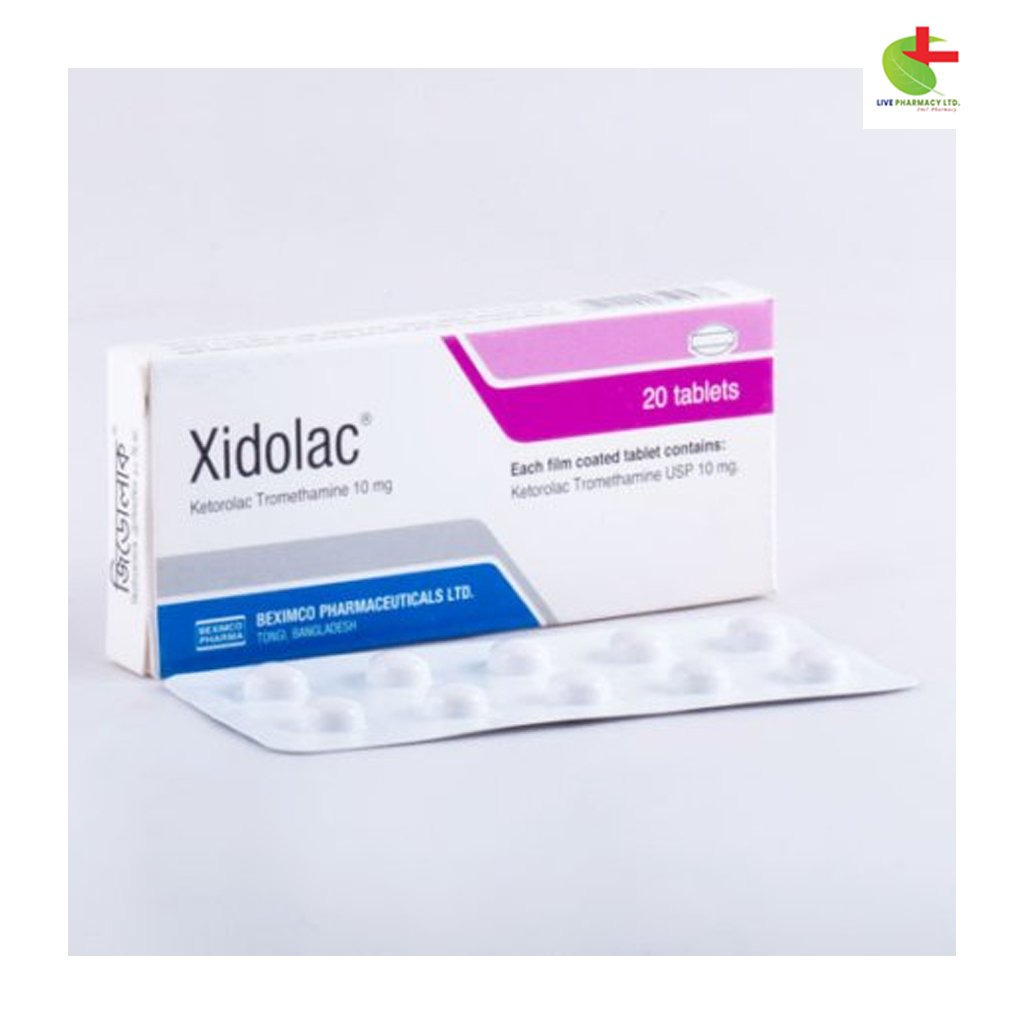Xidolac 10
100.00৳ Strip
- Xidolac is a potent NSAID used for short-term relief of moderate to severe acute post-operative pain.
- It is also effective in reducing inflammation and light sensitivity after ocular surgery, and can alleviate eye redness due to seasonal allergies.
- Xidolac works by inhibiting prostaglandin synthesis, providing effective pain and inflammation management.
 Brand
Brand
|
Beximco Pharmaceuticals Ltd |
|---|---|
 Generics
Generics
|
Ketorolac Tromethamine |
 Type
Type
|
Tablet |
Indications
Xidolac is designed for short-term management of moderate to severe acute post-operative pain. It is also effective in alleviating pain, inflammation, and light sensitivity following ocular surgery. Additionally, Xidolac ophthalmic solution can reduce eye inflammation or redness caused by seasonal allergies.
Description
Xidolac, a member of the pyrrolo-pyrrole group of nonsteroidal anti-inflammatory drugs (NSAIDs), contains ketorolac. Chemically known as 5-benzoyle-2,3-dihydro-1H-pyrrolo[1,2-a]quinoline-1-carboxylic acid, it works by inhibiting prostaglandin synthesis, which helps reduce pain and inflammation. Xidolac is highly protein-bound and metabolized in the liver, with its metabolites and some unchanged drug excreted via urine.
Pharmacology
Ketorolac Tromethamine, the active ingredient in Xidolac, is a potent NSAID. It alleviates pain by inhibiting the cyclooxygenase enzyme system, which in turn decreases prostaglandin production. While it has minimal anti-inflammatory effects at analgesic doses, it is highly effective in pain management.
Dosage & Administration
- Tablet: Take one 10 mg tablet every 4-6 hours, up to a maximum of 40 mg per day. Use only for short-term relief (up to 7 days); not recommended for chronic use.
- Injection: For moderate to severe pain, administer IV or IM doses as follows:
- IM Dosing:
- Adults <65 years: 60 mg
- Adults >65 years, renally impaired, or <50 kg: 30 mg
- IV Dosing:
- Adults <65 years: 30 mg
- Adults >65 years, renally impaired, or <50 kg: 15 mg
- Children (2-16 years):
- IM Dosing: 1 mg/kg up to 30 mg
- IV Dosing: 0.5 mg/kg up to 15 mg
- Multiple-Dose Treatment:
- Adults <65 years: 30 mg every 6 hours, not exceeding 120 mg/day
- Adults >65 years, renally impaired, or <50 kg: 15 mg every 6 hours, not exceeding 60 mg/day
- Convert from parenteral to oral therapy as soon as possible, ensuring the total daily dose does not exceed 120 mg on the day of transition and 40 mg subsequently. Combined parenteral and oral treatment should not exceed 5 days.
- IM Dosing:
- Eye Drops: Instill 1 drop in each eye 4 times daily.
Always use Xidolac as directed by your healthcare provider.
Drug Interactions
- Other NSAIDs or Aspirin: May increase side effects.
- Anti-coagulants: Enhance anti-coagulant effects.
- Beta Blockers: May reduce anti-hypertensive efficacy.
- ACE Inhibitors: Increase risk of renal impairment.
- Methotrexate: May increase toxicity.
Contraindications
Do not use Xidolac if you are hypersensitive to ketorolac or other NSAIDs, in children under 16, or as a prophylactic analgesic before surgery.
Side Effects
Common side effects include nausea, vomiting, gastrointestinal bleeding, peptic ulcer, pancreatitis, drowsiness, headache, thirst, fatigue, bradycardia, hypertension, palpitations, chest pain, infertility in females, and pulmonary edema.
Pregnancy & Lactation
Xidolac is classified as FDA pregnancy category C. It should be avoided during pregnancy and lactation unless the benefits outweigh the risks.
Precautions & Warnings
Use caution in patients over 65 years, those with active or suspected peptic ulcers, gastrointestinal bleeding, asthma, or liver dysfunction. For eye drops, discontinue use if corneal epithelial breakdown is detected and avoid while wearing contact lenses.
Therapeutic Class
Non-opioid analgesics and drugs used for rheumatoid arthritis.
Storage Conditions
Store in a cool, dry place away from light and heat. Keep out of reach of children.













Reviews
There are no reviews yet.